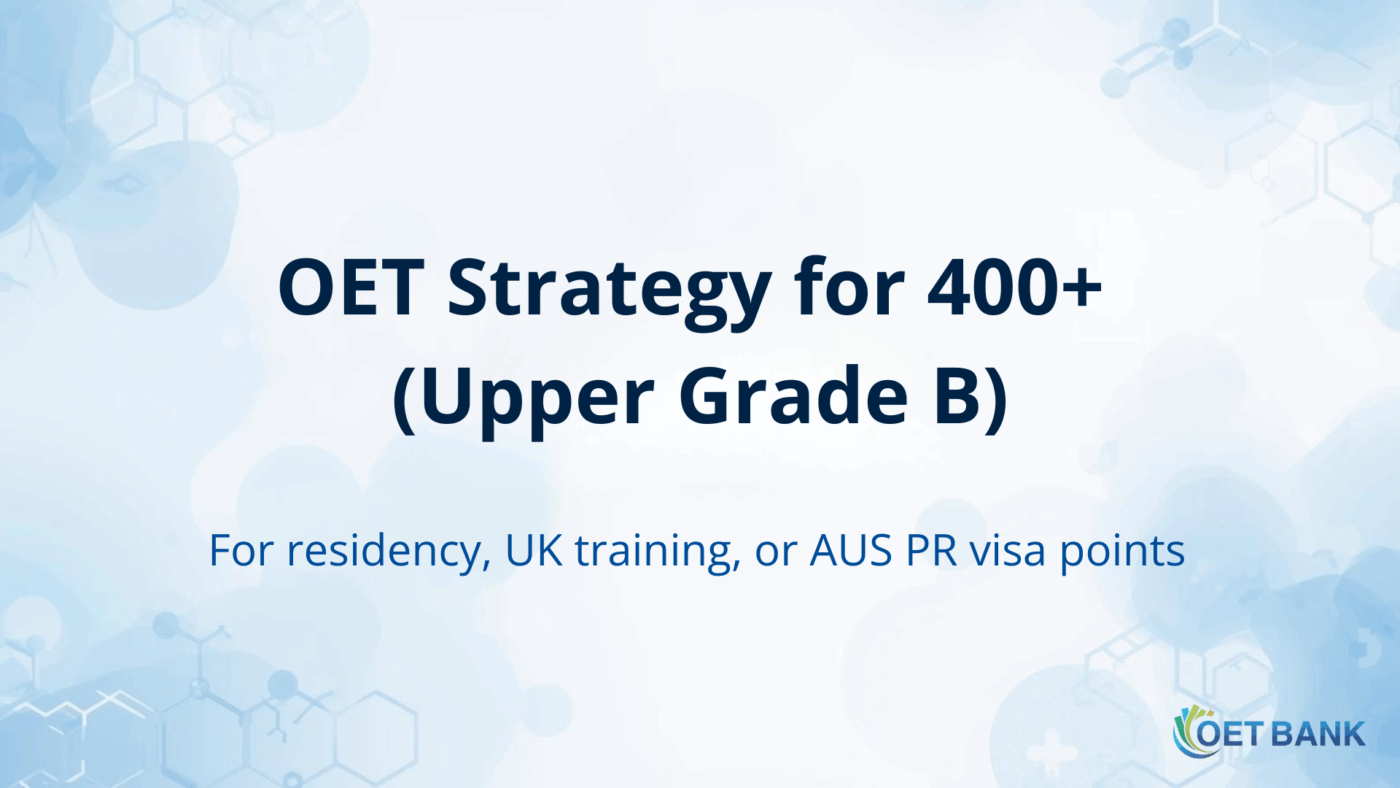Listening, OET Strategies, Reading, Speaking, Writing
OET Strategy for Achieving 400+ (Upper Grade B) Scores
If you’ve already achieved a solid Grade B in OET, you might be wondering—how do I push further into the 400 range?
This article breaks down realistic strategies to aim for 400 or higher, focusing on what differentiates “passing” performance from truly confident professional communication abroad.
OET Strategy for Achieving 400+ Scores
Each OET sub-test is scored from 0 to 500, and converted into Grades A to E.
For most IMGs, Grade B (350–440) is the key target. Since both 350 and 440 fall under B, many learners naturally focus on simply reaching 350.
However, certain residency programs, UK foundation placements, or even Australia’s permanent residency (PR) visa applications explicitly reward or require scores of 400 or above.
And between 350 and 400 lies a surprisingly steep wall: based on years of teaching experience, the vast majority of candidates who pass OET land between 350 and 390.
In short, scoring 400 requires not only proficiency but also precise strategy and targeted practice.
Reading
To reach 400 in OET Reading, you’ll typically need around 35 correct answers out of 42.
The term “around” matters—OET uses scaled scoring, so exact cutoffs vary slightly by test difficulty.
Aiming for 400 consistently means targeting something like:
- Part A: 18 / 20
- Part B: 5 / 6
- Part C: 12 / 16
Since Part A is more predictable, near-perfect accuracy here is essential. While nerves may cause small slips on test day, your practice performance should consistently approach full marks.
Parts B and C are more interpretive. You’ll need about 80% accuracy—something impossible without strong critical reading skills.
Rather than matching surface words, train yourself to ask: “What is the writer actually trying to say?”
Also, master the skill of comparative elimination—weighing all answer options carefully to identify which one fits best, not just which one looks plausible.
Listening
Listening is often the toughest skill for IMGs. To hit 350, about 30 correct answers may suffice.
But for 400+, you’ll again need roughly 35 correct—distributed as:
- Part A: 20 / 24
- Part B: 5 / 6
- Part C: 10 / 12
At the 350 level, relying on Part A is a valid approach.
For 400+, you must also perform strongly in Parts B and C, where subtle reasoning and global comprehension are tested.
To bridge that gap, move beyond repetition drills or dictation.
Develop your ability to separate the “big picture” from the details in real time:
“This part is the key point.”
“This is just an example.”
That instinct—prioritizing essential information as you listen—defines high-level performance.
Also, diversify your input: medical podcasts, dramas, and YouTube discussions expand your ear for varied accents and contextual phrasing beyond OET textbooks.
Writing
In OET Writing, Grade B (350) corresponds roughly to 27 / 38 points, achieved by consistent 5 / 7 scores across most criteria.
To reach 400, you’ll need around 31 / 38, meaning near-perfect 7 / 7 in at least one category and 5–6 elsewhere.
Because even one weak criterion can block 400, balance matters more than brilliance.
While 350 requires a functional and clear letter, 400 demands a refined one—concise, reader-friendly, and purpose-driven.
Key techniques:
- State the purpose clearly—in one opening sentence.
The reader should grasp the letter’s intent immediately, and every paragraph should reinforce it. - Select only relevant information.
Many fall short by adding unnecessary details—or cutting too much.
Ask yourself: “Is this essential for the reader to act?” - Use logical paragraphing and appropriate tone.
Each paragraph should follow a clear theme and logical order (chronological or by importance).
Tone must remain professional yet empathetic—aim for a style that helps the recipient act without confusion. - Maintain linguistic precision.
Minor grammar or spelling errors can cloud meaning.
Moreover, repetitive phrasing limits your ceiling. Use natural paraphrasing and varied structures to sound both accurate and human.
Regularly compare your writing with official graded samples and ask:
“Why did I phrase it this way?”
“Would the reader understand it instantly?”
That reflection habit is what pushes you into the higher B band.
Reference: OET Graded Writing Sample
Speaking
OET Speaking has no official pass mark, but it’s scored out of 39 — very similar to Writing.
Reaching 400 typically means around 32/39 points total, such as 20 / 24 for Linguistic Criteria and 12 / 15 for Clinical Communication.
At 350, it’s enough to communicate clearly. At 400+, you must show professional precision, empathy, and structure—the hallmarks of a confident healthcare communicator.
Focus on these 4 techniques:
- Clear pronunciation and natural intonation
Emphasize key words and vary tone to highlight meaning—crucial for Intelligibility. - Smooth flow and pacing
Limit hesitations or self-corrections. A few are natural, but the conversation should move with steady rhythm. - Patient-friendly language
Simplify medical jargon appropriately and adapt your tone to the patient’s mood or literacy level.
Clarity is a professional skill—not simplification. - Structure and empathy
High scorers organize their role-plays clearly—“Let’s move on to …” or “Based on what you said …”—and respond with genuine empathy.
That raises your Relationship Building score.
Recording yourself and practicing empathy phrasing daily builds the awareness needed for the 400 range.
Reference: Graded Speaking Samples
Study with OET BANK
Stop wasting time comparing OET materials.
With OET BANK, you get:
- Premium-quality OET materials, built by professionals
- A focused, efficient study path — no unnecessary content
- A system designed to help you pass OET once — without trial and error
If you want to prepare properly and pass with confidence,
you don’t need to look anywhere else.
Pick your materials and start today — with OET BANK.




